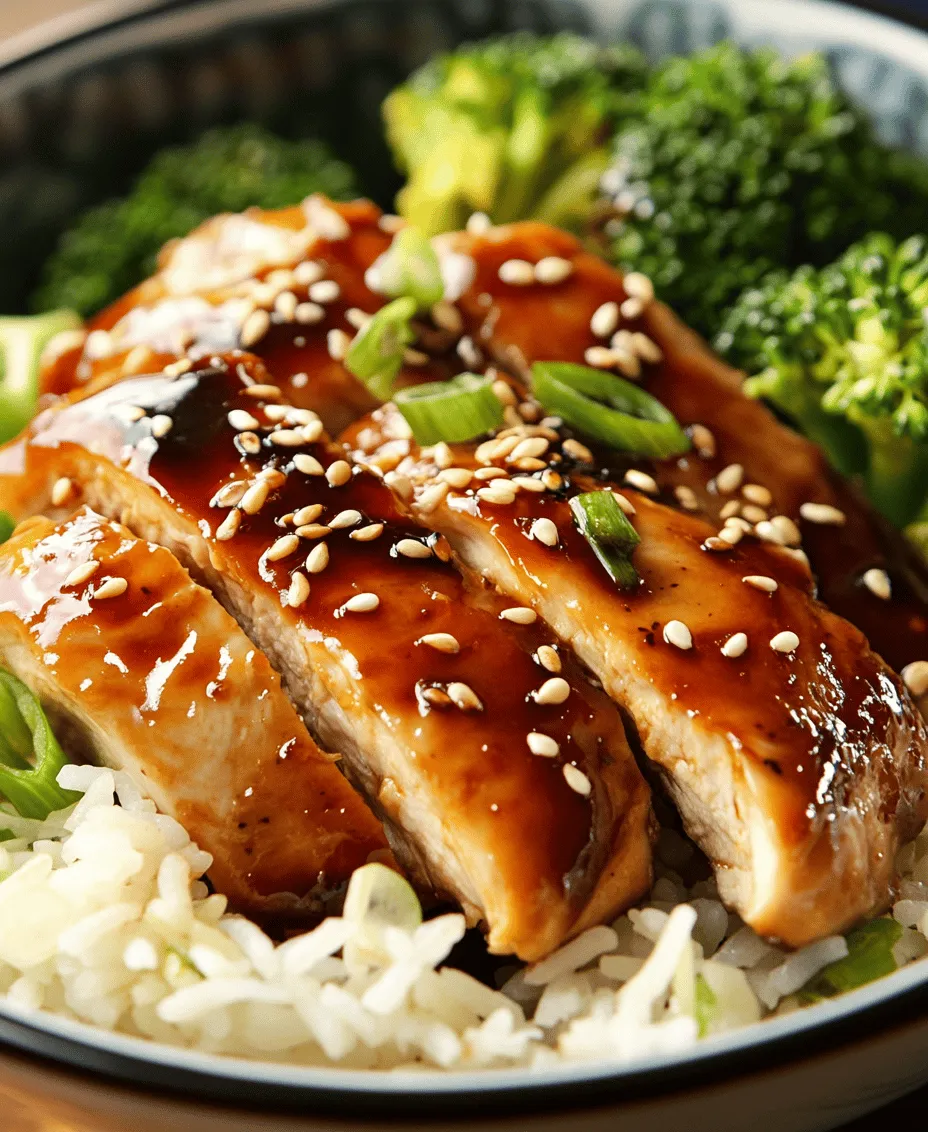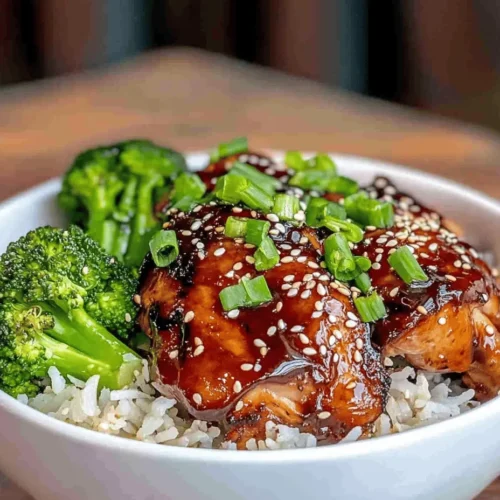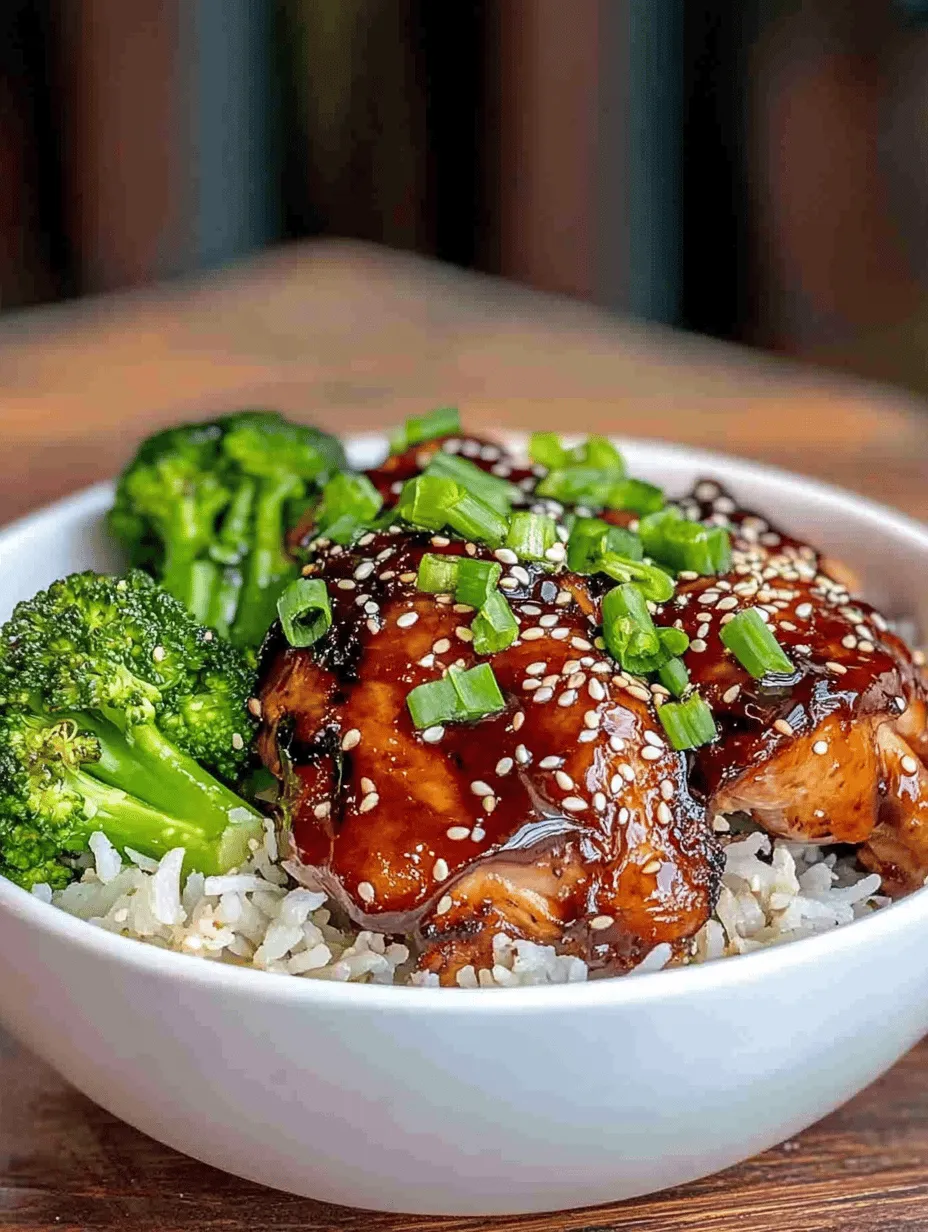Introduction
The Teriyaki Chicken Rice Bowl is a beloved dish that beautifully encapsulates the essence of Japanese cuisine. With its delightful balance of flavors, textures, and nutritional benefits, this dish has gained immense popularity not just in Japan but across the globe. The teriyaki sauce, with its sweet, salty, and umami characteristics, elevates the dish, making it a captivating choice for both home cooks and restaurant patrons.
In this article, we will delve deeper into the cultural significance of teriyaki in Japanese cooking, explore the intricacies of preparing a homemade Teriyaki Chicken Rice Bowl, and guide you through each step to create this delicious meal at home.
The Cultural Significance of Teriyaki in Japanese Cooking
Teriyaki, which translates to “glaze” or “to shine” (teri meaning glaze and yaki meaning grill), reflects a cooking method that has been celebrated in Japan for centuries. Originally, teriyaki was a technique used to prepare fish, particularly in the 17th century. However, as culinary practices evolved, chicken became a popular staple in teriyaki dishes, leading to the creation of the Teriyaki Chicken Rice Bowl we know today.
The teriyaki method is not just a way of cooking; it symbolizes the Japanese philosophy of balancing flavors and presentation. The vibrant colors of the dish—glossy, glazed chicken atop a bed of fluffy rice, often accompanied by fresh vegetables—make it visually appealing while showcasing the meticulous nature of Japanese culinary traditions.
This dish is often prepared at home for family meals or enjoyed at casual dining establishments, making it accessible to a wide audience. Its global appeal lies in its adaptability; variations exist in different cultures, catering to diverse taste preferences while still honoring the essence of the original recipe.
Understanding Teriyaki Sauce
At the heart of the Teriyaki Chicken Rice Bowl is the teriyaki sauce, a key element that imparts the dish’s signature flavor. Traditional teriyaki sauce is a harmonious blend of soy sauce, sake, mirin, and sugar, creating a complex flavor profile that is simultaneously sweet and savory.
The Flavor Profile: Sweet, Salty, and Umami
The combination of these ingredients lends teriyaki sauce its characteristic taste. Soy sauce provides the salty depth, while mirin—a sweet rice wine—adds a subtle sweetness that balances the saltiness. The sugar, often in the form of brown sugar or honey, enhances this sweetness, creating a glaze that caramelizes beautifully when cooked.
The addition of sake introduces a depth of flavor that enhances the overall umami experience, making it a favorite among those who appreciate rich, savory dishes. This umami element is a cornerstone of Japanese cuisine, often sought after in various dishes, and teriyaki is no exception.
Variations of Teriyaki Sauce Across Different Cultures
While the traditional Japanese teriyaki sauce is widely recognized, numerous adaptations exist in other cultures. In Western cuisine, for instance, teriyaki sauce might be thickened with cornstarch or even include additional ingredients like pineapple juice or barbecue sauce for a unique twist. This adaptability showcases the versatility of teriyaki, allowing home cooks to experiment and create versions that cater to their personal taste.
The Benefits of Homemade Teriyaki Chicken Rice Bowl
Preparing a Teriyaki Chicken Rice Bowl at home offers numerous advantages that extend beyond taste. Not only do you have complete control over the ingredients, but you can also tailor the dish to meet your dietary preferences and restrictions.
Nutritional Advantages of Preparing Meals at Home
Homemade meals are typically healthier than takeout, as you can choose fresh, high-quality ingredients and control the amount of sugar, salt, and unhealthy fats. By making your own teriyaki sauce, you avoid preservatives and additives commonly found in store-bought versions, ensuring a healthier meal for you and your family.
Cost-Effectiveness: Breaking Down the Cost of Ingredients
In addition to health benefits, cooking at home is often more economical than dining out. The ingredients for a Teriyaki Chicken Rice Bowl are relatively inexpensive and can feed multiple people. A simple breakdown includes:
– Boneless, skinless chicken thighs: A cost-effective source of protein
– Jasmine rice: Affordable and flavorful, a staple in many households
– Soy sauce and mirin: Used sparingly, these pantry staples last for several meals
– Fresh ginger and garlic: Affordable aromatics that enhance flavor
– Garnishes like green onions and sesame seeds: Add a fresh touch without breaking the bank
By preparing this dish at home, you not only save money but also invest in your health with every bite.
Customization Possibilities to Cater to Dietary Preferences
One of the most significant advantages of making your own Teriyaki Chicken Rice Bowl is the opportunity for customization. Whether you are gluten-free, low-sugar, or seeking vegetarian options, the ingredients can be easily modified. For instance, you can substitute soy sauce with tamari for a gluten-free version or use maple syrup instead of sugar for a healthier sweetener.
Vegetarians can replace chicken with tofu or a medley of vegetables, allowing everyone to enjoy the delightful flavors of teriyaki without compromising their dietary preferences.
Ingredient Breakdown
Before diving into the cooking process, it’s crucial to understand the key ingredients that make up the Teriyaki Chicken Rice Bowl. Each component plays a significant role in flavor, texture, and overall satisfaction.
Boneless, Skinless Chicken Thighs
For this recipe, boneless, skinless chicken thighs are preferred due to their juicy texture and rich flavor. Unlike chicken breasts, which can dry out during cooking, thighs remain moist and tender, especially when marinated in teriyaki sauce. Their higher fat content contributes to a more flavorful dish, making them an ideal choice for this recipe.
Jasmine Rice
As a base for the dish, jasmine rice is chosen for its fragrant aroma and slightly sticky texture. This long-grain rice complements the teriyaki chicken perfectly, absorbing the sauce while providing a satisfying chew. The light, floral notes of jasmine rice enhance the overall dining experience, making it a favorite in many Asian dishes.
Soy Sauce and Mirin
Quality soy sauce and mirin are essential for achieving an authentic teriyaki flavor. Look for naturally brewed soy sauce, as it tends to have a richer taste compared to mass-produced versions. Mirin, a sweet rice wine, adds depth to the sauce and balances the salty flavors of the soy sauce. Using high-quality ingredients ensures that your teriyaki sauce will shine.
Fresh Ginger and Garlic
Fresh ginger and garlic are indispensable in enhancing the flavor of the teriyaki sauce. Ginger adds a warm, slightly peppery note, while garlic contributes a savory punch that elevates the dish. Both ingredients are known for their health benefits, including anti-inflammatory properties, making them a wholesome addition to your meal.
Sesame Oil, Green Onions, and Sesame Seeds
These garnishing components provide not only flavor but also visual appeal. A drizzle of sesame oil adds a nutty aroma, while chopped green onions contribute freshness and a pop of color. Toasted sesame seeds can be sprinkled on top for added crunch. Together, these ingredients create a beautifully presented dish that is sure to impress.
Optional Ingredient Substitutions for Dietary Needs
For those with specific dietary requirements, there are numerous substitutions you can make. For a gluten-free version, replace soy sauce with gluten-free tamari. If you are watching your sugar intake, opt for a sugar substitute like stevia or reduce the amount of mirin used. These small adjustments allow you to enjoy the Teriyaki Chicken Rice Bowl without sacrificing flavor or dietary preferences.
Step-by-Step Cooking Instructions
Now that we have a solid understanding of the ingredients and their significance, let’s move on to the cooking process. This section will guide you through each step to ensure your Teriyaki Chicken Rice Bowl turns out perfectly.
Cooking the Rice
1. Rinse the Jasmine Rice: Begin by rinsing the jasmine rice under cold water to remove excess starch. This step is crucial, as it prevents the rice from becoming overly sticky during cooking.
2. Cook the Rice: In a medium saucepan, combine the rinsed rice and water (or broth for added flavor) in a 1:1.5 rice-to-water ratio. Bring to a boil, then reduce the heat to low, cover the pot, and let it simmer for about 15 minutes. Once the water is absorbed, remove from heat and let it sit, covered, for an additional 10 minutes to allow the rice to steam. This will result in perfectly fluffy jasmine rice.
Preparing the Teriyaki Sauce
1. Combine Ingredients: In a small saucepan over medium heat, combine soy sauce, mirin, sugar, minced garlic, and grated ginger. Stir the mixture until the sugar dissolves completely.
2. Cook the Sauce: Allow the sauce to come to a gentle simmer. Continue cooking for about 5-7 minutes, until the sauce thickens slightly and reaches a glossy consistency. Keep an eye on it to ensure it doesn’t boil over.
3. Taste and Adjust: This is the crucial step where you can adjust the flavor to your liking. If you prefer a sweeter sauce, add a bit more sugar or honey. For a bolder flavor, a dash of extra soy sauce can enhance the saltiness.
These initial steps set the stage for creating a Teriyaki Chicken Rice Bowl that is not only delicious but also a reflection of the culinary art rooted in Japanese tradition. In the next part of this article, we will explore the process of cooking the chicken and assembling the final dish, showcasing how to combine these flavors into a satisfying meal. Stay tuned for the continuation of this culinary adventure.

Cooking the Chicken
To craft the perfect Teriyaki Chicken Rice Bowl, the chicken must be cooked to perfection. The technique of browning the chicken is crucial for developing flavor and texture. Start by cutting the chicken breast into evenly sized pieces, about 1-inch cubes, which will help them cook uniformly.
Browning Techniques
1. Preheat the Pan: Use a non-stick skillet or a cast-iron pan and heat it over medium-high heat. A hot pan is essential for searing the chicken, allowing it to develop a beautiful golden-brown crust.
2. Oil Choice: Add a tablespoon of oil with a high smoke point, such as canola or grapeseed oil. This prevents the chicken from sticking to the pan and helps in achieving a crisp exterior.
3. Don’t Crowd the Pan: Place the chicken pieces in a single layer, giving them enough space to brown properly. If necessary, cook the chicken in batches to avoid overcrowding, which can lead to steaming instead of browning.
4. Cooking Time: Sauté the chicken for about 5-7 minutes, turning occasionally. You want the chicken to be golden brown on all sides. The internal temperature should reach 165°F (75°C) to ensure it is fully cooked and safe to eat.
5. Resting: Once cooked, remove the chicken from the pan and let it rest for a few minutes. This allows the juices to redistribute, keeping the chicken tender and moist.
Combining Flavors
Now that your chicken is perfectly cooked, it’s time to add the teriyaki sauce. The timing of this step is crucial, as adding the sauce too early can cause it to burn.
1. Deglaze the Pan: After removing the chicken, add a splash of water or chicken broth to the hot pan, scraping up any browned bits stuck to the bottom. This enhances the flavor of the teriyaki sauce.
2. Add the Sauce: Pour in the prepared teriyaki sauce, allowing it to simmer for a minute. This helps to thicken the sauce slightly. Then, return the chicken to the pan, tossing it to coat evenly.
3. Final Touch: Cook for an additional 2-3 minutes, ensuring the chicken is well coated and heated through. The goal is to create a glossy finish without burning the sugars in the sauce.
Visual Aids
Incorporating step-by-step photos or diagrams can greatly enhance the clarity of your cooking process. Consider documenting each stage: from preparing the ingredients, through the cooking process, to plating the completed dish. Visual aids not only guide the reader but also inspire confidence in their cooking abilities.
Serving Suggestions and Pairings
Once your Teriyaki Chicken Rice Bowl is ready, consider some delightful side dishes and garnishes to complement the main dish.
Ideas for Side Dishes
Steamed Broccoli and Mixed Vegetables:
These are not only easy to prepare but also add a lovely crunch and nutritional value to your meal. Steam fresh broccoli along with a mix of bell peppers, snap peas, and carrots for about 5-7 minutes until tender yet crisp. This provides a beautiful color contrast and boosts fiber and vitamin intake.
Preparation Tips:
– For added flavor, season the vegetables with a sprinkle of sesame oil and a pinch of salt.
– A drizzle of soy sauce or a sprinkle of sesame seeds can enhance their taste further.
Additional Garnishes
Enhancing your Teriyaki Chicken Rice Bowl with garnishes can elevate the presentation and flavor:
– Avocado: Sliced or diced avocado adds creaminess and healthy fats.
– Pickled Vegetables: These provide a tangy contrast to the sweetness of teriyaki sauce. Consider using pickled ginger or radishes.
– Fresh Herbs: Chopped green onions or cilantro can add a fresh burst of flavor.
Beverage Pairings
To complement your meal, consider pairing with beverages that enhance the flavors of the dish:
– Green Tea: Offers a refreshing and slightly bitter contrast to the sweetness of teriyaki.
– Sake: A chilled or warm sake can elevate the dining experience, pairing beautifully with the savory notes of the chicken.
– Sparkling Water with Lime: This is a refreshing non-alcoholic option that cleanses the palate.
Nutritional Information
The Teriyaki Chicken Rice Bowl is not only delicious but also a balanced meal option.
Overview of Nutritional Benefits
This dish provides an excellent source of protein, essential carbohydrates, and healthy fats. The chicken serves as a lean protein source, while the rice provides energy through carbohydrates. The vegetables contribute vitamins, minerals, and fiber, making it a well-rounded choice.
Macronutrient Breakdown
Here’s a rough breakdown of macronutrients per serving:
– Protein: Approximately 30 grams (from chicken)
– Fats: Around 10 grams (from cooking oil and garnishes)
– Carbohydrates: About 45 grams (from rice)
Calorie Count and Portion Control
A standard serving of the Teriyaki Chicken Rice Bowl typically ranges between 450-600 calories, depending on the portion sizes and specific ingredients used. For those mindful of their caloric intake, consider controlling portions of rice or sauce.
Cultural Context and Variations
Understanding the cultural background of teriyaki can enrich your appreciation of this dish.
The Role of Teriyaki in Japanese Cuisine
Teriyaki, which translates to “grilled” or “broiled” with a glaze, has its roots in Japanese cuisine. Traditionally, fish was used, but over time, chicken became a popular choice, especially in Western adaptations. The dish has evolved to incorporate various ingredients and cooking methods, making it a favorite around the globe.
Regional Adaptations
As teriyaki chicken gained popularity, many regions adapted it to local tastes. In Korea, for instance, you might find a spicy version, while in Hawaii, teriyaki chicken is often marinated in a sweeter sauce and served with rice and macaroni salad.
Popular Variations of the Rice Bowl Concept
The rice bowl concept is prevalent in many cultures. Dishes like Bibimbap from Korea or Donburi from Japan showcase the versatility of rice as a base. Each variation offers unique flavors, toppings, and sauces, making rice bowls a global favorite.
Storing and Reheating Leftovers
If you find yourself with leftovers, proper storage and reheating are essential for maintaining freshness and flavor.
Guidelines for Proper Storage
1. Cool Down: Allow the Teriyaki Chicken Rice Bowl to cool to room temperature before storing it.
2. Airtight Containers: Place the leftovers in airtight containers to keep moisture in and prevent the absorption of other flavors in the fridge.
3. Refrigeration: Store in the refrigerator for up to 3 days. For longer storage, consider freezing; it can last up to 3 months in a freezer-safe container.
Best Practices for Reheating
1. Microwave: For quick reheating, use a microwave. Place in a microwave-safe bowl, cover with a damp paper towel, and heat in intervals of 1 minute until heated through.
2. Stovetop: For a better texture, reheat on the stovetop. Add a little water or broth to the pan to prevent drying out, and heat over medium until warmed through.
Frequently Asked Questions
Common Queries Regarding the Recipe
1. Can I substitute the chicken?
Absolutely! You can use tofu for a vegetarian option or beef for a different flavor profile.
2. Is there a gluten-free version of teriyaki sauce?
Yes, look for gluten-free soy sauce or tamari, which can be used to make a gluten-free teriyaki sauce.
3. Can I make this dish low-carb?
For a low-carb version, substitute rice with cauliflower rice or spiralized vegetables.
Dietary Concerns
This dish can be easily modified to cater to various dietary needs. For instance, you can use low-sodium soy sauce for a healthier option or adjust the sugar content in the teriyaki sauce for those monitoring their sugar intake.
Conclusion
The Teriyaki Chicken Rice Bowl is a delightful dish that combines savory flavors, vibrant colors, and a satisfying texture, making it a versatile choice for any meal. Whether you’re cooking for family or hosting friends, this recipe is sure to impress.
With its cultural significance and adaptability, the Teriyaki Chicken Rice Bowl represents the joy of cooking at home. Sharing this meal with loved ones fosters connections and creates lasting memories around the dinner table. So, gather your ingredients, follow the steps, and enjoy the art of preparing this delicious dish!



